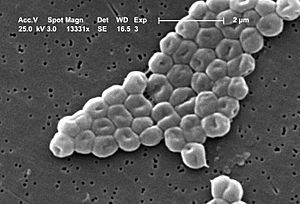Pseudomonadales facts for kids
Quick facts for kids Pseudomonadales |
|
|---|---|
 |
|
| Acinetobacter baumannii | |
| Scientific classification | |
| Kingdom: | |
| Phylum: | |
| Class: | |
| Order: |
Pseudomonadales
Orla-Jensen, 1921
|
| Families and Genera | |
|
|
The Pseudomonadales are a group of tiny living things called bacteria. They belong to a larger family of bacteria known as Proteobacteria. These bacteria are special because they are "gram-negative". This means they have a thin cell wall that doesn't hold a special purple dye used in labs.
Some types of Pseudomonadales can cause problems. They are known as pathogens, which means they can make people or animals sick. For example, a bacterium called Pseudomonas aeruginosa can sometimes lead to a serious illness called sepsis. Sepsis is when the body's reaction to an infection harms its own tissues and organs.
But not all Pseudomonadales are harmful! Some, like Azomonas and Azotobacter, are very helpful. They can "fix nitrogen". This means they can take nitrogen gas from the air and turn it into a form that plants can use to grow. This is super important for healthy soil and plants.
Contents
What are Pseudomonadales?
Pseudomonadales are a specific order of bacteria. Think of "order" like a big group in a family tree of living things. All bacteria in this order share similar features. They are usually rod-shaped and can move around using tiny whip-like tails called flagella.
These bacteria are found almost everywhere. You can find them in soil, water, and even inside living things. They are very adaptable and can live in many different environments.
Families of Pseudomonadales
The Pseudomonadales order is divided into different families. The main families are the Moraxellaceae and the Pseudomonadaceae. Each family contains different types of bacteria, called genera (plural of genus).
Moraxellaceae
The Moraxellaceae family includes several interesting bacteria.
- Acinetobacter: These bacteria are often found in soil and water. Some types can cause infections, especially in hospitals.
- Moraxella: These are common bacteria that can live in the human body without causing harm. However, some types can cause ear infections or bronchitis.
- Psychrobacter: These bacteria are known for being able to grow in very cold places, like the Arctic or Antarctic.
Pseudomonadaceae
The Pseudomonadaceae family is another important group.
- Pseudomonas: This is a very large group. Many Pseudomonas bacteria are found in soil and water. They are known for being very adaptable. Some types, like Pseudomonas aeruginosa, can cause infections. Others are used in bioremediation to clean up pollution.
- Azotobacter and Azomonas: As mentioned before, these bacteria are amazing because they help plants by fixing nitrogen. They turn nitrogen gas into a usable form for plants, which is like giving them a natural fertilizer.
See also
 In Spanish: Pseudomonadales para niños
In Spanish: Pseudomonadales para niños

